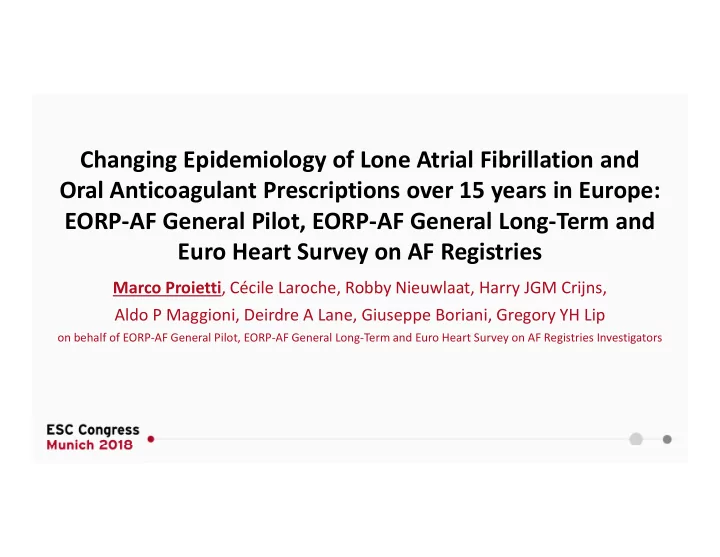

Changing Epidemiology of Lone Atrial Fibrillation and Oral Anticoagulant Prescriptions over 15 years in Europe: EORP-AF General Pilot, EORP-AF General Long-Term and Euro Heart Survey on AF Registries Marco Proietti , Cécile Laroche, Robby Nieuwlaat, Harry JGM Crijns, Aldo P Maggioni, Deirdre A Lane, Giuseppe Boriani, Gregory YH Lip on behalf of EORP-AF General Pilot, EORP-AF General Long-Term and Euro Heart Survey on AF Registries Investigators
Lone AF Large variation exists in definitions among the available evidence Lone AF is defined as AF in young patients (<60 years) or in patients with minimally or no heart disease. More precisely it is the absence of clinical history or echocardiographic evidence of concomitant cardiovascular or pulmonary conditions or an acute trigger for AF. Camm AJ EHJ 2010 ;31:2369; Wyse DG JACC 2014 ;63:1716
Lone AF Lone AF has been considered as a condition burdened by a low risk of adverse events and not worthy of OAC treatment. Jahangir A Circulation 2007 ;115:3050; Camm AJ EHJ 2010 ;31:2369
AIM Aim of this study is to describe the epidemiology, associated risk factors and prescription of OAC among Lone AF patients over 15 years across three European Society of Cardiology observational registries on AF: (i) EORP-AF Pilot Registry (ii) EORP-AF Long-Term Registry (iii) Euro Heart Survey on AF Registry
Methods Lone AF was defined as follows: Absence of clinical or echocardiographic other cardiovascular diseases (including hypertension), associated pulmonary disease, cardiac abnormalities or congenital diseases or age <65 EHS on AF 2005 EORP-AF LT 2017 years. Prevalence, Clinical Profile, Thromboembolic Risk and OAC prescription in Lone AF patients were evaluated overall and across the three registries. EORP-AF Pilot 2014
Results EHS on AF EORP-AF LT Overall Prevalence N= 19548 6.4% 7.9% 6.9% 93.6% 92.1% Lone AF Other EORP-AF Pilot Lone AF Other 3.9% 93.1% p<0.001 96.1% Lone AF Other Lone AF Other
Results Age Type of AF 58.0 50% 47.6% 46.7% 45% 56.0 56.0 38.8% 40% 35% 54.0 31.7% 30% 52.0 26.7% 52.0 24.0% 24.0% Median 25% 20.8% 20.3% 20% 50.0 15% 48.3 48.0 8.7% 10% 5.5% 4.5% 5% 46.0 0.8% 0.0% 0.0% 0% First Detected AF Paroxysmal AF LS Persistent AF Persistent AF Permanent AF 44.0 EHS on AF EORP-AF Pilot EORP-AF LT EHS on AF EORP-AF Pilot EORP-AF LT
Results 100% 90% 77.7% 80% 71.3% 70% 62.1% 60% 50% 40% 30.3% 28.1% 28.0% 30% 24.6% 20.2% 19.2% 18.5% 16.7% 20% 14.9% 7.7% 10% 4.4% 3.5% 1.8% 1.6% 1.2% 0.3% 0.0% 0.0% 0% Female Smoking Habit Symptomatic AF Diabetes Mellitus Stroke/TIA Hyperlipidaemia Renal Disease EHS on AF EORP-AF Pilot EORP-AF LT
Results CHA 2 DS 2 -VASc ≥2 CHA 2 DS 2 -VASc 25% 100% 90% 21.1% 80% 75.8% 20% 67.2% 70% 60% 15% 51.5% 50% 40% 30.3% 10% 27.4% 30% 21.5% 20% 14.3% 5% 10% 4.8% 2.7% 2.7% 1.6% 1.6% 2.5% 0.8% 0.0% 0.0% 0.0% 0.0% 0.0% 0.2% 0.0% 0.0% 0.2% 0% 0 1 2 3 4 5 6 0% EHS on AF EORP-AF Pilot EORP-AF LT EHS on AF EORP-AF Pilot EORP-AF LT
Results 75% Use of Any OAC 70% 75% 62.0% 65% 70% 64.8% 60% 65% 60.0% 55% 60% 50.5% 50% 55% 52.1% 43.7% 45% 50% 39.5% 44.6% 40% 45% 35% 40% 27.0% 27.1% 30% 35% 25% 20.8% 30% 20% 16.8% 25% 15% 20% 8.1% 10% 15% 2.8% 5% 1.6% 10% 0.0% 0% 5% No Antithrombotic Only Antiplatelet Only OAC Antiplatelet + OAC 0% EHS on AF EORP-AF Pilot EORP-AF LT Overall EHS on AF EORP-AF Pilot EORP-AF LT
Results Univariate Logistic Regression for OAC Prescription OR (95% CI) Multivariate Logistic Regression for OAC Prescription Age 1.05 (1.04-1.06) Type of AF* OR (95% CI) Paroxysmal 1.34 (1.01-1.77) Age 1.04 (1.03-1.05) LS Persistent 11.60 (3.49-38.56) Type of AF* Persistent 4.471 (3.12-6.41) Paroxysmal 1.28 (0.95-1.74) Permanent 3.13 (1.87-5.25) LS Persistent 9.41 (2.79-31.71) Diabetes Mellitus 2.40 (1.40-4.10) Persistent 3.94 (2.69-5.79) Hyperlipidaemia 1.58 (1.17-2.14) Permanent 2.45 (1.36-4.43) Symptomatic Status† Smoking Habit 0.70 (0.51-0.95) Previously Symptomatic 0.55 (0.37-0.82) Stroke/TIA 17.20 (2.28-129.73) Currently Symptomatic 0.77 (0.55-1.08) No Physical Activity 1.35 (1.03-1.75) Smoking Habit 0.54 (0.41-0.72) Stroke/TIA 10.06 (2.40-42.18) Registry EHS on AF - *First Detected as reference EORP-AF Pilot 0.74 (0.49-1.13) †Never Symptomatic as reference EORP-AF LT 1.69 (1.30-2.20)
Conclusions • Over the last 15 years patients with Lone AF increased and were progressively more burdened with non-cardiac stroke risk factors. • Baseline thromboembolic risk is progressively increasing • A significant change in treatment has been found, with OAC prescription increased over time • Among other predictors, history of Stroke/TIA is the clinical factor more strongly associated with OAC prescription • Future analysis on major clinical event risks and role of OAC therapy will further elucidate the actual risk in Lone AF patients
Recommend
More recommend